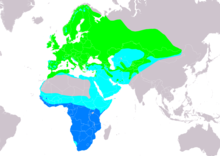斑鶲
斑鶲(學名:Muscicapa striata)為鶲科鶲屬的鳥類。是舊世界鶲科的一種小型雀形目鳥類,主要在歐洲和古北界至西伯利亞繁殖,並具有候鳥特性,冬季遷徙至非洲和西南亞。該物種的模式產地在荷蘭。[1]它的分佈範圍在部分地區正在減少。
| 斑鶲 | |
|---|---|

| |
| 捷克共和國 | |
| 科學分類 | |
| 界: | 動物界 Animalia |
| 門: | 脊索動物門 Chordata |
| 綱: | 鳥綱 Aves |
| 目: | 雀形目 Passeriformes |
| 科: | 鶲科 Muscicapidae |
| 屬: | 鶲屬 Muscicapa |
| 種: | 斑鶲 M. striata
|
| 二名法 | |
| Muscicapa striata | |

| |
| M. striata 分佈範圍 繁殖區 過境 非繁殖區
| |
| 異名 | |
|
M. grisola L.[2] | |

這種鳥外觀並不顯眼,具有長翅膀和長尾巴。成鳥的上半身為灰褐色,下半身為白色,頭頂和胸部有條紋,這也是它名稱的由來。[3] 腿短且黑色,喙呈黑色,形狀寬闊但尖細,這是空中食蟲鳥類的典型特徵。幼鳥比成鳥更偏棕色,且上半身有斑點。
分類學
編輯斑鶲於1764年由德國博物學家彼得·西蒙·帕拉斯描述,並命名為Motacilla striata。[4][5][6] 屬名Muscicapa源自拉丁文,musca意為蒼蠅,capere意為捕捉。種小名striata來自拉丁文striatus,意為帶條紋的。[7]
已確認有五個亞種,牠們均在非洲南部越冬,繁殖範圍如下:[8][9]
- M. s. striata(Pallas,1764年) – 歐洲至西西伯利亞,西北非洲
- M. s. inexpectata(Dementiev,1932年) – 克里米亞(烏克蘭南部)
- 斑鶲新疆亞種 M. s. neumanni(Poche,1904年) – 愛琴海群島至中東、外高加索、伊朗北部及中部西伯利亞。在中國大陸,分佈於新疆等地。該物種的模式產地在非洲。[10]
- M. s. sarudnyi(Snigirewski,1928年) – 伊朗東部、土庫曼斯坦至中亞和巴基斯坦北部山區
- M. s. mongola(Portenko,1955年) – 蒙古和西伯利亞南部
以前曾認定兩個其他亞種,M. s. tyrrhenica和M. s. balearica。然而,2016年發表的一項分子系統發生學研究顯示,這兩個亞種在基因上彼此相似,但與其他斑鶲亞種顯著不同。研究者建議應將這些島嶼亞種視為獨立物種。[11]國際鳥盟已將其分裂,稱為地中海鶲,而其他分類學機構仍認為它們是同種。
描述
編輯斑鶲是一種體型纖細的小鳥,體長約14.5 cm(5.7英寸),體重約14—20 g(0.49—0.71 oz)。它的上半身為暗淡的灰褐色,下半身為灰白色。頭頂、喉部和胸部有棕色條紋,翅膀和尾羽的邊緣有較淺的細條紋。[12] 亞種M. s. tyrrhenica的上半身顏色較淡且偏暖色,頭部和胸部的標記較模糊。[13] 雌雄外觀相似。幼鳥上半身有赭色斑點,下半身則有鱗狀棕色斑點。[9]
行為與生態
編輯斑鶲會從顯眼的棲息處捕捉飛過的昆蟲,捕食後通常會返回同一棲木。它們直立的姿勢非常具特徵。
大多數雀形目鳥類的飛羽換羽順序是從靠近身體的羽毛開始向外進行。然而,斑鶲的特殊之處在於它們會先替換外側的飛羽,然後才是靠近身體的羽毛。[14][15]
斑鶲的叫聲是一種細長、柔和且高音的tssssseeeeeppppp,音調略微下降。
繁殖
編輯斑鶲喜愛在落葉林、公園和花園等樹木稀疏的開闊地區繁殖。它們會在牆壁凹處築開放式巢,並樂於使用開口式巢箱。每次產下4至6顆卵。
大多數歐洲鳥類無法區分自己的卵與其他物種的卵。例外的是大杜鵑的寄主鳥類,牠們為了抵禦巢寄生已經進化出這種技能。斑鶲擁有優秀的卵辨識能力,這可能表明它曾經是杜鵑的寄主,但由於卵辨識能力太強,最終擺脫了寄生。而林岩鷚則恰恰相反,牠似乎是較新的杜鵑寄主,因為牠沒有顯示出卵辨識的能力。[16]
掠食
編輯在英格蘭南部兩個不同地點進行的一項研究發現,有三分之一的巢遭到掠食。松鴉(Garrulus glandarius)是最常見的空中掠食者,會吃卵和雛鳥。家貓(Felis catus)掠食的巢數量較少。[17]
Gallery
編輯參考文獻
編輯- ^ 1.0 1.1 中國科學院動物研究所. 斑鶲. 《中國動物物種編目數據庫》. 中國科學院微生物研究所. [2009-04-04]. (原始內容存檔於2016-03-05).
- ^ Muscicapa grisola Linnaeus. GBIF. [2023-11-23].
- ^ Spotted Flycatcher. Wildlife in Norfolk. Norfolk Wildlife Trust. [3 May 2019].
- ^ Mayr, Ernst; Cottrell, G. William. Check-list of Birds of the World. Volume 11 11. Cambridge, Massachusetts: Museum of Comparative Zoology. 1986: 314.
- ^ Sherborn, C. Davies. The new species of birds in Vroeg's catalogue, 1764. Smithsonian Miscellaneous Collections. 1905, 47: 332–341 [336]. Includes a transcript of the 1764 text.
- ^ Rookmaaker, L.C.; Pieters, F.F.J.M. Birds in the sales catalogue of Adriaan Vroeg (1764) described by Pallas and Vosmaer. Contributions to Zoology. 2000, 69 (4): 271–277. doi:10.1163/18759866-06904005 .
- ^ Jobling, James A. The Helm Dictionary of Scientific Bird Names. London, United Kingdom: Christopher Helm. 2010: 260, 367. ISBN 978-1-4081-2501-4..
- ^ Gill, Frank; Donsker, David (編). Chats, Old World flycatchers. World Bird List Version 6.2. International Ornithologists' Union. 2016 [20 May 2016].
- ^ 9.0 9.1 Taylor, B. Spotted Flycatcher (Muscicapa striata). del Hoyo, J.; Elliott, A.; Sargatal, J.; Christie, D.A.; de Juana, E. (編). Handbook of the Birds of the World Alive. Lynx Edicions. 2020 [17 June 2016]. S2CID 216294072. doi:10.2173/bow.spofly1.01.
- ^ 中國科學院動物研究所. 斑鶲新疆亚种. 《中國動物物種編目數據庫》. 中國科學院微生物研究所. [2009-04-04]. (原始內容存檔於2016-03-05).
- ^ Pons, J.-M.; Thibault, J.-C.; Aymí, R.; Grussu, M.; Muntaner, J.; Olioso, G.; Sunyer, J.R.; Touihri, M.; Fuchs, J. The role of western Mediterranean islands in the evolutionary diversification of the spotted flycatcher Muscicapa striata, a long-distance migratory passerine species. Journal of Avian Biology. 2016, 47 (3): 386–398. doi:10.1111/jav.00859.
- ^ Snow, D.W.; Perrins, C.M. (編). Spotted Flycatcher (Muscicapa striata). The Birds of the Western Palearctic. Concise Edition. Volume 2: Passerines. Oxford: Oxford University Press. 1998: 1349–1352. ISBN 0-19-850188-9.
- ^ Viganò, M.; Corso, A. Morphological differences between two subspecies of spotted flycatcher Muscicapa striata (Pallas, 1764) (Passeriformes Muscicapidae) (PDF). Biodiversity Journal. 2015, 6 (1): 271–284.
- ^ Jenni, Lukas; Winkler, Raffael. Moult and Ageing of European Passerines. London, San Diego: Academic Press. 1994. ISBN 0-123-84150-X.
- ^ Svensson, Lars. Identification Guide to European Passerines 4th. Stockholm: L. Svensson. 1992: 34, 222–223. ISBN 91-630-1118-2.
- ^ Davies, N. B.; Brooke, M. de L. An experimental study of co-evolution between the Cuckoo, Cuculus canorus, and its hosts. I. Host egg discrimination. Journal of Animal Ecology. 1989, 58 (1): 207–224. Bibcode:1989JAnEc..58..207D. JSTOR 4995. S2CID 56303051. doi:10.2307/4995.
- ^ Stevens, D.K.; Anderson, G.Q.A.; Grice, P.V.; Norris, K.; Butcher, N. Predators of Spotted Flycatcher Muscicapa striata nests in southern England as determined by digital nest-cameras. Bird Study. 2008, 55 (2): 179–187. Bibcode:2008BirdS..55..179S. doi:10.1080/00063650809461520 .